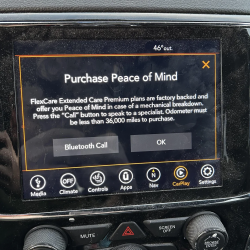Jeep Rolls Out In-Car Ads, Sparking Driver Outrage
In a move that has left drivers both frustrated and bewildered, Jeep, a subsidiary of Stellantis, has introduced in-car pop-up advertisements on its vehicles’ infotainment systems. These ads, which appear every time the vehicle comes to a stop, have been met with widespread criticism from Jeep owners who feel their in-car experience is being compromised.
A New Level of Intrusion

The advertisements, which promote Mopar’s extended warranty service, take over the entire infotainment screen, forcing drivers to manually close them to access basic vehicle functions such as navigation and music. This intrusive advertising has been compared to the much-hated pop-up ads that have plagued internet users for decades.
Jeep owners have taken to social media and online forums to express their dissatisfaction. One owner posted a photo showing a persistent pop-up ad on their Jeep Grand Cherokee’s display, pushing them to buy the FlexCare plan for “peace of mind.” Similar frustrations have been reported by owners of other Jeep models, including the Wrangler 4xe and Gladiator.
Stellantis Responds
Stellantis, the parent company of Jeep, has acknowledged the issue, attributing it to a temporary software glitch that affected the ability to opt out of the ads in some cases. The company claims to have identified and corrected the error and is following up with affected customers to ensure the matter is resolved.
However, the response from Stellantis has done little to quell the dissatisfaction among drivers. The company’s “JeepCares” representative advised users to tap the “X” to dismiss the ads and mentioned efforts to reduce their frequency. But this explanation has not satisfied many owners, who see the ads as a significant intrusion into their driving experience.
The Future of In-Car Advertising
The introduction of in-car pop-up ads raises important questions about the future of automotive advertising. As vehicles become more connected, automakers are exploring new revenue streams, but at what cost to the driver’s experience? Safety advocates have expressed concerns that such ads could divert drivers’ attention, increasing the risk of accidents.
Moreover, the use of in-car advertising raises privacy issues. For these ads to be effective, vehicles must collect and transmit data about drivers’ habits, locations, and preferences. This has led to concerns about how this data is used, stored, and shared.
A Call for Transparency
As the backlash against Jeep’s in-car ads continues, there is a growing call for transparency from automakers. Drivers want to know how their data is being used and demand the option to opt out of such intrusive features. The balance between monetization and user experience will be crucial for automakers to maintain customer loyalty in the connected car era.